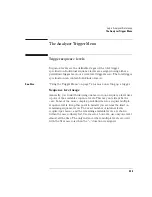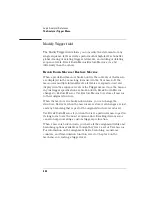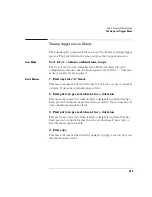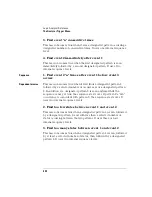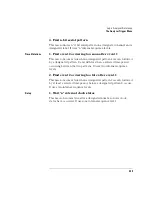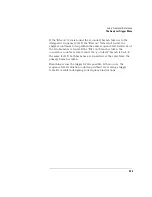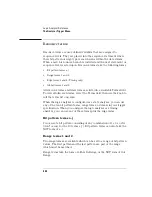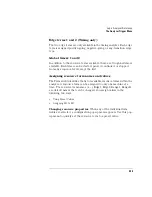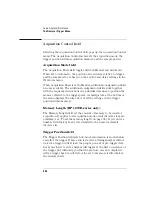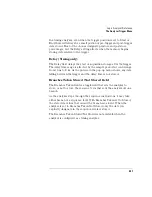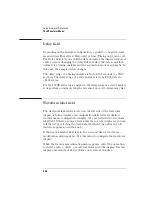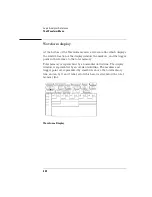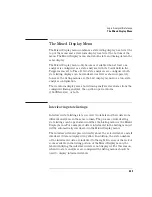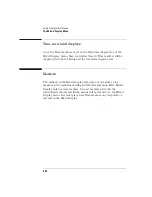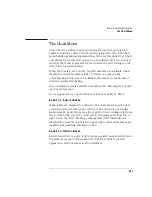
337
Logic Analyzer Reference
The Analyzer Trigger Menu
After the assignment menu closes, you may see "$" indicators in the
field display. A "$" indicates the assignment can’t be displayed in the
selected base because of Don’t Cares. When you display the
assignment in binary, however, you can see the actual pattern.
Range terms.
Range terms require an upper and lower bit pattern
boundary. The range is recognized as the data that is numerically
between or on the two specified boundaries. In addition, the range
must be contained in a single label across a single pod pair, with no
clock bits allowed.
Timer terms.
Timers are either true or false. Timers start as you enter
the sequence level, and when the count expires, the it becomes true. If
a timer is paused in one level, it must be continued in another level
before it can count through.
As more sequence levels are added, the timer status in the new levels
defaults to Off. Timers must be continued or started in each new level
if it is appropriate. When a timer expires or stops, its count resets to
zero.
Combination of terms
Combination terms are configured and selected from within trigger
sequence levels. All user-defined resource terms can be combined to
create complex qualifiers that occupy a single assignment field space.
When you select the term field in a Sequence Level menu, a pop-up
selection list appears. If you then select "Combination," a logical
assignment menu appears. Use this menu to turn on resource terms
and input them into a chain of logical operators.
When the combination is placed in the assignment field, if the term is
too long to fit in the assignment field, the display is truncated.
Summary of Contents for 1670E Series
Page 6: ...6 In This Book...
Page 26: ...26 Contents...
Page 27: ...27 Section 1 Logic Analyzer...
Page 28: ...28...
Page 29: ...29 1 Logic Analyzer Overview...
Page 39: ...39 2 Connecting Peripherals...
Page 49: ...49 3 Using the Logic Analyzer...
Page 72: ...72 Using the Logic Analyzer The Inverse Assembler...
Page 73: ...73 4 Using the Trigger Menu...
Page 101: ...101 5 Using the Oscilloscope...
Page 151: ...151 6 Using the Pattern Generator...
Page 199: ...199 7 Triggering Examples...
Page 237: ...237 8 File Management...
Page 249: ...249 9 Logic Analyzer Reference...
Page 360: ...360 Logic Analyzer Reference The Compare Menu...
Page 361: ...361 10 System Performance Analysis SPA Software...
Page 397: ...397 11 Logic Analyzer Concepts...
Page 430: ...430 Logic Analyzer Concepts The Analyzer Hardware Oscilloscope board theory Oscilloscope board...
Page 439: ...439 12 Troubleshooting the Logic Analyzer...
Page 455: ...455 13 Specifications...
Page 471: ...471 14 Operator s Service...
Page 479: ...479 Operator s Service Troubleshooting Troubleshooting Flowchart 2...
Page 491: ...491 Section 2 LAN...
Page 492: ...492...
Page 493: ...493 15 Introducing the LAN Interface...
Page 497: ...497 16 Connecting and Configuring the LAN...
Page 506: ...506 Connecting and Configuring the LAN Connecting and Configuring the LAN...
Page 507: ...507 17 Accessing the Logic Analyzer File System Using the LAN...
Page 515: ...515 18 Using the LAN s X Window Interface...
Page 527: ...527 19 Retrieving and Restoring Data Using the LAN...
Page 539: ...539 20 Programming the Logic Analyzer Using the LAN...
Page 546: ...546 Programming the Logic Analyzer Using the LAN Programming the Logic Analyzer Using the LAN...
Page 547: ...547 21 LAN Concepts...
Page 555: ...555 22 Troubleshooting the LAN Connection...
Page 580: ...580 Troubleshooting the LAN Connection Getting Service Support...
Page 581: ...581 Section 3 Symbol Utility...
Page 582: ...582...
Page 583: ...583 23 Symbol Utility Introduction...
Page 588: ...588 Symbol Utility Introduction Symbol Utility Introduction...
Page 589: ...589 24 Getting Started with the Symbol Utility...
Page 597: ...597 25 Using the Symbol Utility...
Page 609: ...609 26 Symbol Utility Features and Functions...

